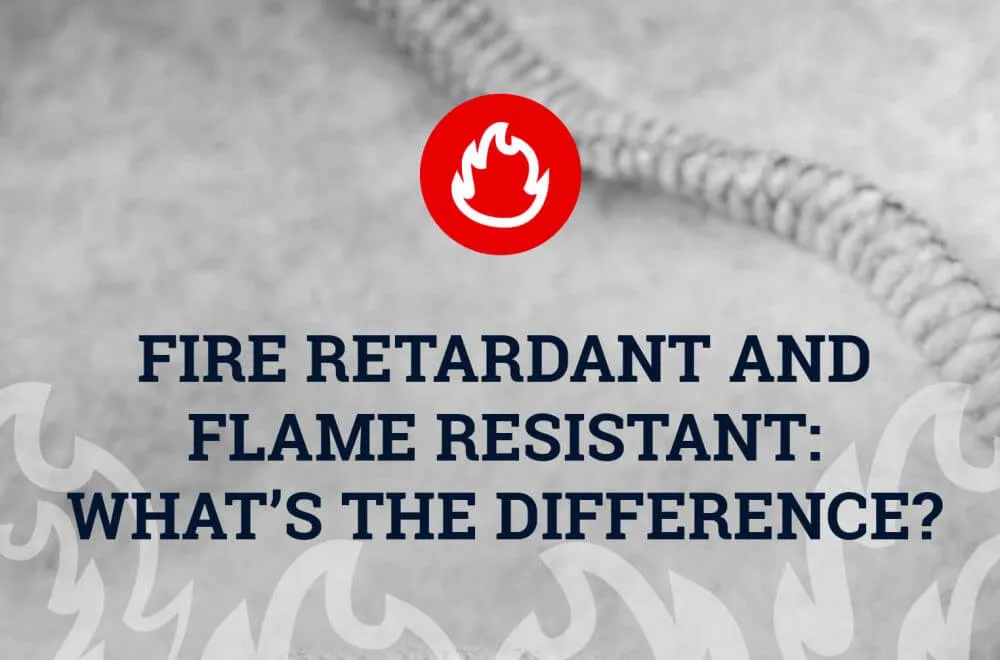Flame-retardant and flame-resistant fabrics: what’s the difference?

There is a lot of confusion between fabric that is seen as flame-resistant or flame-retardant. While these two phrases sound similar, their meaning is quite different, as the fabric undergoes very different processes for it to be protective. Below, we will clarify the main differences and explain the features of both terms.
Flame-Retardant Fabrics
Flame-retardant fabrics have the ability to slow or halt the spread of fire. These fabrics can be made from many types of material. That is because fire-retardancy is achieved through a chemical finish that is applied directly onto the fabric, which delays the possible impact of fire on the fabric. Typical applications are:
- home furniture
- carpets
- and curtains
What such fabrics have in common is that they are not (frequently) cleaned in wet-processes. The finish is not penetrated and bonded deeply into the fabric, so it will wash off when cleaned. This means that such fabrics may require a new FR finish (re-application) after they are cleaned.
So in a nutshell, the finish is not deeply bonded to the fabric and will be washed off during cleaning. As such, flame-retardant fabrics are not suitable for protective garments. However, the definitions of flame-retardant and flame-resistant are often mixed up, by the market and even by ourselves.
Flame-Resistant Fabrics
Flame-resistant fabrics, on the other hand, are permanently flame-resistant. They cannot be set alight from being in or close to a fire because they are self-extinguishing. Therefore, flame-resistant fabrics are suitable for protective garments.
There are 2 categories of flame-resistant fabrics. One is FR-treated, where the fabric is treated with FR chemicals that bond deeply into it. The other is inherent FR fabrics, which are made of fibres that are already made flame-resistant.
-
Flame-resistant treated fabric (FR-treated)
Flame-resistant fabrics that are treated with FR chemicals, also called THPC chemicals, are chemically bonded to the cellulose part of the fabric blend. Examples of cellulose fibres include cotton, viscose and TENCEL™ Lyocell fibres. This THPC treatment makes the fabric permanently flame-resistant, which means it is not negatively affected by frequent cleaning. FR-treated flame-resistant fabric thus doesn't require re-application of an FR finish after washing.
FR- treated fabrics have a very good level of protection against molten metal, heat, and ARC. Such fabrics are also cheaper in cost than fabrics that are inherently flame-resistant.
-
Inherent flame-resistant fabrics (inherent FR)
Inherent flame-resistant fabrics offer good protection in addition to their ability to be very stable in colour performance during cleaning. The flame-resistant properties are interwoven within the fabric fibres and therefore cannot wash out during industrial laundering.
These fabrics have great heat and ARC protection as well as colourfastness, even after frequent laundering. Generally, they also offer good comfort levels and retain their lightweight feel and clean look.
One drawback is that these fabrics offer limited protection when it comes to molten metal splash. Another downside of using flame-resistant fabrics is the cost. Since these fibres go through a more intricate process to be flame-resistant, costs associated with this procedure are generally higher.
Selecting The Right Fabric for Your Team
There are a number of factors that need to be considered when selecting the right flame-resistant fabric for your workplace. These include the potential risks encountered by wearers, the particular industry, and the overall needs of wearers when it comes to PPE.
If you need more information about the flame-resistant fabrics available on the market, please don’t hesitate to contact us. We will be happy to advise you further.
